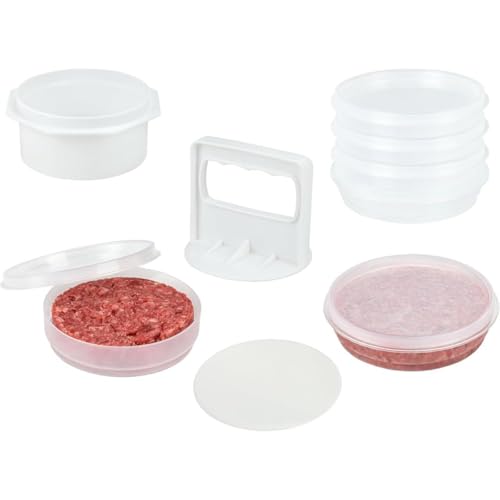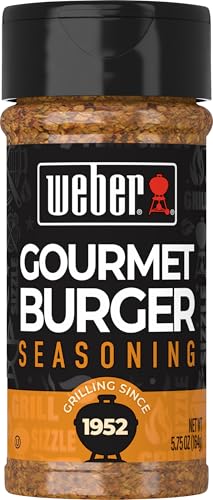Key Takeaways
- Understanding the Options: Both manual and electric burger patty makers offer unique benefits, affecting the overall burger-making experience and personal cooking preferences.
- Advantages of Manual Makers: Manual patty makers provide hands-on control, portability, cost-effectiveness, and skill development, making them ideal for casual grilling and individual creativity.
- Benefits of Electric Makers: Electric patty makers streamline the burger-making process through efficiency, consistency, ease of use, and versatility, perfect for those hosting larger gatherings.
- Comparative Performance: Manual makers shine in small gatherings for their personal touch, while electric machines excel in efficiency and uniformity for larger batches, catering to different grilling occasions.
- Price Considerations: Manual patty makers are budget-friendly, whereas electric ones entail a higher initial investment but offer added convenience and precision in the long run, affecting overall cost-effectiveness.
- Personal Preferences: The decision between manual and electric patty makers ultimately depends on individual cooking style, frequency of use, and budget, emphasizing the importance of choosing a tool that aligns with personal grilling goals.
When it comes to crafting the perfect burger, the right tools can make all the difference. As a burger enthusiast, I’ve often found myself debating the merits of manual versus electric patty makers. Each option has its charm and unique benefits, making the choice a bit tricky for anyone looking to elevate their grilling game.
Overview of Burger Patty Makers
Burger patty makers transform the way I craft my burgers. Choosing between manual and electric options can significantly influence the burger-making process.
Manual Patty Makers
Manual patty makers rely on muscle power and technique. These tools provide hands-on control over the patty shape and thickness. I enjoy the tactile experience, shaping the meat just right. They’re often smaller and easier to store, making them great for casual grilling at home. For example, when hosting a backyard barbecue, I appreciate their simplicity and ability to produce perfectly uniform patties quickly.
Electric Patty Makers
Electric patty makers automate the process, offering precision and efficiency. These machines compress meat consistently, reducing cooking time and ensuring even doneness. I find them invaluable when preparing multiple burgers at once. With features like built-in heating elements, some electric makers even allow for simultaneous cooking. They can simplify the burger-making journey, especially when experimenting with different blends of meat or ingredients.
Both options serve distinct needs. Manual makers let me embrace tradition, while electric devices provide speed and convenience. The best choice often comes down to personal preference and cooking style.
Manual Burger Patty Makers
I love the art of making burgers, and manual burger patty makers bring a unique charm to the process. These tools put you in control of your patty’s shape and thickness, allowing for a truly personalized burger experience.
Advantages of Manual Makers
- Hands-on Control: Manual makers let me shape the patties exactly how I want them. I can control the thickness, ensuring they cook evenly on the grill.
- Portability: Since manual makers don’t require electricity, I can take them wherever I go. Grilling at the park? No problem.
- Cost-effective: Manual patty makers are often more affordable than their electric counterparts. It’s a simple tool that gets the job done without breaking the bank.
- Durability: These makers tend to have fewer moving parts. They usually last longer with little maintenance, making them a great investment for any burger lover.
- Skill Development: Using a manual maker helps improve my burger-making technique. The process encourages me to learn more about meat handling and cooking times.
Disadvantages of Manual Makers
- Labor-intensive: Manual makers require a bit of muscle. If I’m making a large batch for a family gathering, it can get tiring fast.
- Inconsistent Results: Achieving uniformity in size can be tricky at times; slight variations in shaping can affect cooking and taste.
- Time-consuming: Preparing multiple patties can take longer with a manual maker compared to the efficiency of an electric model. When I host cookouts, I sometimes find this frustrating.
- Limited Features: Manual makers don’t come with the extra features often found in electric models, like built-in temperature gauges. This means I must rely more on my instincts and how well I know my grill.
- Requires Practice: Mastering the technique takes time. New users may find it challenging at first, but it’s a rewarding learning process for those who are up for the challenge.
Electric Burger Patty Makers
Electric burger patty makers revolutionize the way I craft burgers, offering a mix of convenience and precision. These machines simplify the process, allowing me to focus more on creativity and flavor combinations.
Advantages of Electric Makers
- Efficiency: Electric patty makers speed up the process, letting me shape multiple patties in minutes. This efficiency is particularly helpful when I’m grilling for gatherings, saving valuable time.
- Consistency: These machines ensure uniform patty sizes, providing a consistent cooking experience. I enjoy the evenness, as it enhances my burger presentations and ensures that everyone’s burger is cooked the same way.
- Ease of Use: Operating electric makers is simple. I plug it in, set the portion size, and let it do the work. This ease means I can experiment with different flavors and ingredients without getting bogged down in the mechanics.
- Time-Saving: The automatic feature is a game-changer for preparing large batches. I can focus on other grill items while the machine shapes patties, making efficient use of my cooking time.
- Versatility: Many electric models allow me to mix different meats, seasonings, and even stuff patties. This versatility inspires creativity, enabling me to explore unique burger creations with various fillings and flavors.
Disadvantages of Electric Makers
- Cost: Electric patty makers often come with a higher price tag compared to manual options. This investment might not be ideal for everyone, especially those just starting out in their burger-making journey.
- Size and Storage: These machines can be bulky, taking up counter space or requiring dedicated storage. I’ve had to plan my kitchen layout carefully to accommodate my electric maker without feeling cluttered.
- Dependence on Power: If I’m outdoors grilling without an available power source, the electric maker is out of commission. This limitation has me considering alternatives for more adventurous or spontaneous grilling sessions.
- Less Hands-On Experience: The automation can sometimes take away the tactile enjoyment I get from shaping patties myself. While convenience is a perk, I miss the direct engagement in crafting each patty.
- Cleaning: Electric models typically involve more components for cleaning compared to manual makers. Maintenance can be a bit tedious, requiring additional time to keep everything in top condition.
With these insights, I appreciate how electric burger patty makers serve my needs in new and exciting ways, even as I navigate the trade-offs they bring.
Comparing Performance
Comparing the performance of manual and electric burger patty makers highlights their strengths and weaknesses, helping fellow enthusiasts decide which option suits their burger-making style.
Manual Patty Makers
Manual patty makers depend on my hands and technique. I enjoy the tactile feedback when shaping patties, allowing me to control the thickness and firmness. I can create unique shapes, too, giving each burger a personal touch. However, achieving consistency takes practice. I find myself occasionally with patties of varying sizes, which can affect cooking time and flavors.
For small gatherings, manual makers shine. I can whip up a few patties while chatting with friends, making the process feel more social. Still, larger batches become labor-intensive, requiring more time and effort. Despite this challenge, the ability to experiment with different seasonings and blends while shaping the patties keeps me motivated.
Electric Patty Makers
Electric patty makers bring another level of convenience to burger preparation. With the press of a button, I can produce perfectly shaped patties in minutes. This efficiency is a game-changer when I’m hosting larger get-togethers. I can create multiple patties quickly and uniformly, ensuring even cooking.
The consistency of size means I’m less likely to overcook or undercook any burger, allowing my friends to experience the same amazing flavors. Cleaning the equipment can be a hassle, but with the right care, it becomes manageable. While electric makers reduce hands-on interaction, they open up opportunities for experimenting with different meat combinations without the physical strain.
Whether I’m shaping patties by hand or letting an electric maker do the work, each method carries unique benefits. It depends on the occasion and my mood, but both enhance the journey of creating delicious, unique burgers in my kitchen.
Price Considerations
When choosing between manual and electric burger patty makers, price plays a significant role. I find that manual patty makers typically range from $10 to $30. These options deliver affordability and simplicity, making them perfect for beginners or casual grillers who appreciate a hands-on approach. Brands like Norpro and OXO offer quality without breaking the bank, allowing me to create delicious patties with ease.
In contrast, electric patty makers come with a higher price tag, generally ranging from $40 to $150. These machines offer efficiency and convenience, catering to serious burger enthusiasts or those hosting larger gatherings. Brands such as Hamilton Beach and George Foreman stand out in this category, providing robust features that justify their price. Despite the upfront investment, I value the time saved and precision achieved during busy cooking sessions.
Also, when assessing the overall cost, consider additional expenses. Manual makers require no electricity, so I save on energy bills, while electric options may increase utility costs. Plus, electric models often necessitate more maintenance and cleaning products.
Ultimately, the choice between manual and electric burger patty makers hinges on personal budget and cooking needs. Balancing upfront costs with the long-term value they bring makes a considerable difference in the burger-making experience.
Conclusion
Choosing between a manual and an electric burger patty maker really comes down to what you enjoy most in the kitchen. I love the hands-on approach of manual makers for their charm and the chance to get creative with my patties. There’s something satisfying about shaping each one myself.
On the flip side, electric patty makers are fantastic for those busy days when I need to whip up a bunch of burgers quickly. They save time and ensure consistency, which is a huge plus for gatherings.
Ultimately, whether you lean towards the traditional or the modern, both types of patty makers can elevate your burger game and bring joy to every grilling session. Happy cooking!











